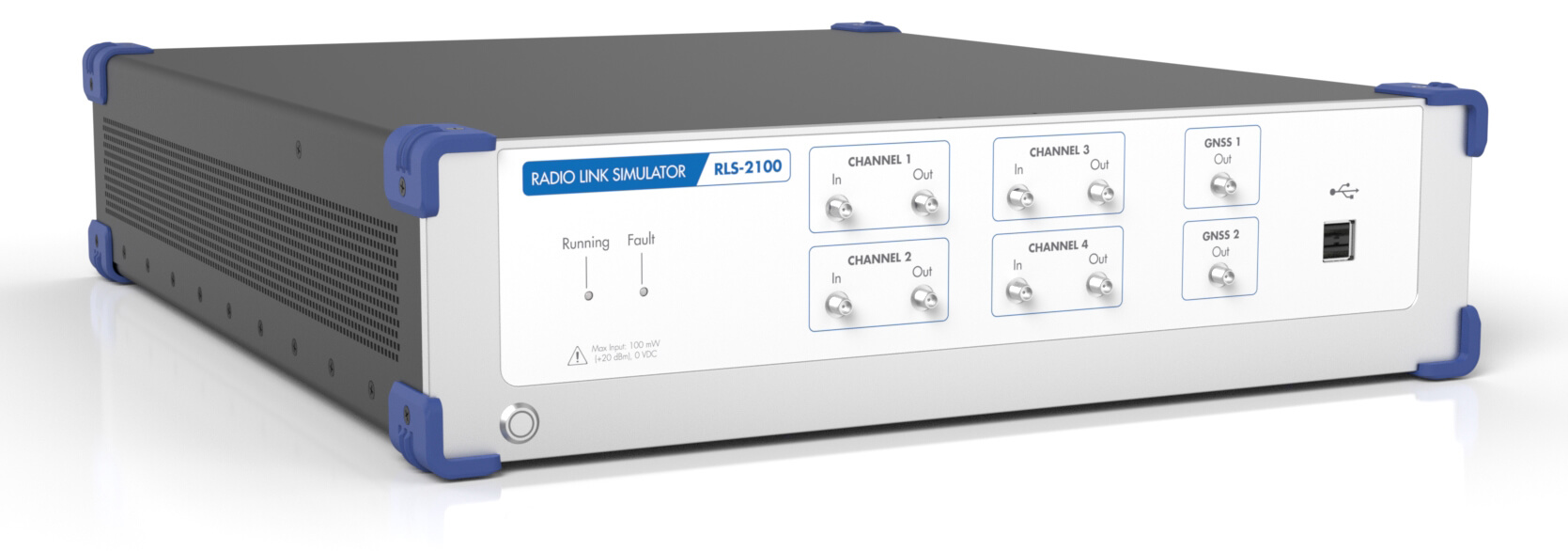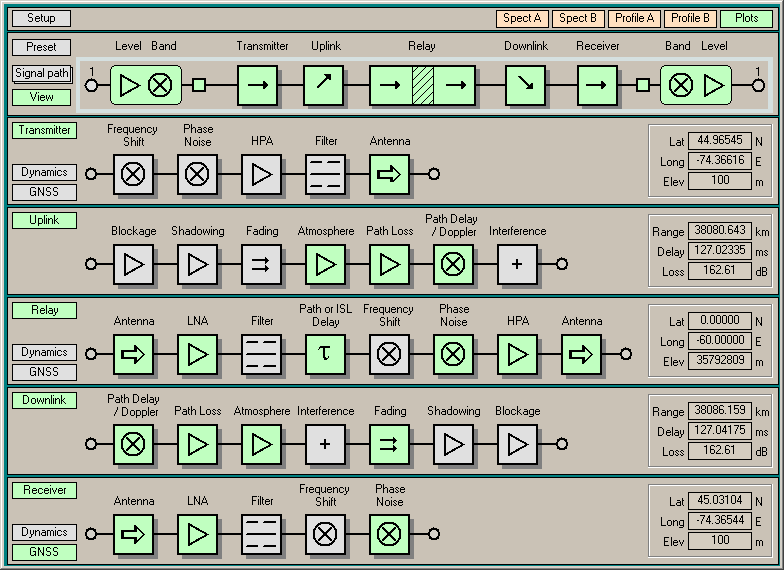Testers & Simulators
RLS-2100 Radio Link Simulator
Bring your satellite link into the lab.
The RLS-2100 Radio Link Simulator revolutionizes satellite link testing.
With a comprehensive set of impairments that can be applied to virtually any wideband scenario, the RLS-2100 is an all-in-one system that gives you total confidence.

The stakes are high — and you need to be sure it works.
The RLS-2100 delivers everything today’s space innovators need.
Wideband radio frequency simulation of transmitters, uplinks, satellites/relays, downlinks, and receivers
Physically accurate modeling of all link conditions, including Doppler, delay, path loss, rain fade and more
See examples of what the RLS-2100 can do for:
A satellite network operator needs to model the performance of their network before expanding an existing GEO network to include LEO satellites.
Using RLS-2100, they are able to:
- Use real hardware to verify the impact of adding LEO satellites to their existing GEO network to extend coverage and increase capacity
- Use integrated modeling of a multi-orbit satellite network to apply varying channel characteristics, including Doppler and dynamic path loss/delay
- Use integrated antenna modeling capabilities to enable realistic simulation of satellite beams of various types
- Verify link performance across the multi-orbit network, including LEO-LEO, LEO-GEO and GEO-GEO beam and satellite handovers
- Verify seamless operation of applications over each satellite constellation and manage the user experience as the network adapts to changing latency, capacity and link conditions
A provider of air traffic control safety services needs to ensure that the performance of their service would not be compromised if Ka-band feeder links were employed.
Using RLS-2100, they are able to:
- Have Square Peg’s team create a test bed based on the radio link simulator that can realistically model their link conditions and mitigation mechanisms, such as uplink power control and site diversity
- Have key satellite propagation characteristics imparted onto the radio link signals passing through it
- Including rain fading events based on ITU models, Doppler, delay, AWGN, phase noise, interference, multipath fading and more
- Applicable link conditions fully synchronized between channels
- Allow the test bed controller to remotely simulate satellite ALC and Uplink Power Control algorithms that automatically adjust signal levels during tests, and to simulate the decision logic used to control site switching
- Adjust the parameters of their power control and site switching algorithms to minimize the effects of rain fade on end-to-end safety service performance — and demonstrate to customers that the required service availability can be achieved
An in-flight connectivity provider needs to ensure gate-to-gate reliability by recreating complex on-air scenarios before flying.
Using RLS-2100, they are able to:
- Verify performance before rolling out new satellite-based services that use a variety of satellite types with different characteristics
- Ensure seamless connectivity by verifying that the satcom selects the appropriate satellite in all scenarios and hands over between beams and satellites reliably and with minimal service impact — while recovering from temporary outages caused by loss of coverage or aircraft maneuvering
- Use integrated modeling of stations in motion, including satellite constellations and aircraft in flight, to create realistic route simulations
- Use the integrated antenna modeling capability to account for realistic antenna gain vs. azimuth and elevation, including keyhole effects caused by the aircraft’s tail
- Use the ARINC 429 interface to provide the airborne satcom with position information fully synchronized with the test scenario
- Improve the robustness of their solution in off-nominal cases such as when signal lost due to aircraft maneuvers during handovers
- Bring their link into the lab to provide significant cost savings vs. running flight trials —while gaining the ability to explore conditions not readily reproduced in a limited number of flight trials
A 5G operator needs to test how satellite links would behave in their new hybrid network.
Using RLS-2100, they are able to:
- Simulate terminal link handovers between their terrestrial and satellite networks
- Use integrated scenario modeling to apply realistic link characteristics for the terminal and satellites in motion
- Identify issues related to maintaining seamless connectivity across handovers due to varying link characteristics and adjust network operation to compensate
- Verify their network performance to reduce risk moving forward
The most versatile and comprehensive tester
The RLS-2100 is the most versatile satellite link tester available — delivering fast, repeatable results. It is the ideal choice to:
- Upgrade test beds for wideband signal compatibility
- Verify link budgets with true hardware-in-the-loop testing
- Test modem performance under dynamic link conditions
- Verify new satellite network configurations
- Prove and refine next generation satellite network concepts prior to deployment
Powerful testing solutions
5G NON-TERRESTRIAL NETWORKS
5G network uptake is exploding. Providers need a reliable way to test wideband 5G links, and to verify seamless handover between the satellite NTN and the terrestrial network.
MILITARY
Varying environments and emerging threats can put essential communications at risk, so satellite-enabled reconnaissance and communications are critical. Militaries need to assess link and application performance in advance of conflicts to ensure mission success.
MULTI-ORBIT CONSTELLATIONS
Innovative satellite operators and service providers are combining LEO, GEO, HEO and MEO constellations as a means of optimizing service performance and availability. Comprehensive validation of these increasingly complex wideband scenarios in the lab is essential.
LEO CONSTELLATIONS
The high performance of Low Earth Orbit satellites is driving incredible growth. Which means there’s a growing need to determine how connecting across LEO satellites will affect a system or application’s performance.
RLS-2100 BASIC OPERATION
Our satellite link tester is easy to set up and use:
- Connect the modem I/O ports to the RLS-2100 I/O ports with RF cables
- Input the location of transmitting and receiving stations
- Load a TLE file to specify the location/orbit of the satellite(s)
- Configure the interface and modeled RF frequencies used for the uplink and downlink paths
- Explore performance aspects by enabling blocks such as delay/doppler, noise, path loss, multipath fading, rain fading, etc.
- The RLS-2100 does all the work to impart the selected characteristics in real-time
Functional Capabilities | |
|---|---|
| Impairments | Independently-specifiable parameters:
|
| Other capabilities |
|
Signal Path | |
| Channels / bandwidth |
|
| Frequency | Std: 700 to 2150 MHz (Independent input/output) Opt: internal 5G FR1 (400 to 7125 MHz) Opt: external 5G FR2 (10.7 to 31 GHz) |
GPS Simulator | |
| Channels | 2, derived from station positions |
| Frequency | 1575.42 MHz (GPS L1) |
Additional Capabilities | |
| Cooperative Units | 4 |
| Remote control | Ethernet via Python API |
| Station position output | Ethernet, ARINC 429 |
| Antenna emulation | OpenAMIP or custom |
| Visualization | Orbit and route animation |
| Spectral display and Power profile display | 4 independent plots, at input or output |
| Link parameter display | 4 independent plots of range, loss, delay, delay rate, Doppler or Doppler rate, for uplink, downlink, ISL or composite path |
Monitor & Control Interfaces | |
| Sync | TTL, configurable as input or output |
| Reference | 100 MHz internal, external or disciplined |
| Ethernet | 10/100/1000 Base T |
| Serial | RS-232/422/485 |
| USB | USB 2.0, USB 3.0 |
| Video | Display Port, HDMI, VGA |
A comprehensive user interface, with full touch screen support, allows real-world scenarios to be mapped directly to the applicable elements in the signal path.

Graphical displays of signal spectrum, power profile, and other parameters are available at points throughout the signal path, facilitating debug of test setups and allowing simple visualization of the effects of the applied impairments.

Take the next step
4017 Carling Avenue, Suite 200
Ottawa, ON, Canada K2K 2A3
Tel + 1 613 271 0044
Fax+ 1 613 271 3007